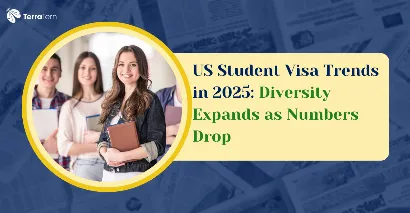Key Highlights
- The American F-1 Student Visa The Changing Face
- Key Stats at a Glance
- The Fall of Indian Outbound Students: Causes and Implications
- The Surge of “Next Wave” Countries
- Causes of the Greater Geographic Diversity
- How Policy and Consular Changes Influence Mobility?
- Addition to Campuses in US And Internationalization
- Comparative Decline: Australian and Canadian Example
- Looking Ahead: What Do These Changes Signal?
- Conclusion
The first half of the 2025 fiscal year came with seismic changes in the landscape of international student migration into the US. The overall issuance of F-1 student visas decreased, but a close look will show the tale of student source shift and altered motives. The huge margin in the lead gone, India experienced a collapse, whereas the new hope was a place revealed by Zimbabwe, Pakistan, and Vietnam. This blog decodes these developments, the reasons underlying the developments, and their implications on the future of global education in America.
The American F-1 Student Visa The Changing Face
About 89,000 F-1 visas were issued by the US Department of State between October 2024 and March 2025, which is a 15 per cent decrease in comparison with the same period in the previous year. Such a change is notable not only due to the relative number of affected individuals but also in patterns and countries as emerging players. The Indian students, who are usually the highest group of students, witnessed a stunning 44 per cent decline in approved visas. Yet India still remained in the leading position, as 14,700 F-1 visas were issued to Indians; however, it was a dwindling lead.
China, on the other hand, was well stabilized at 11,000 visas, which was the same compared to past years. Nevertheless, the most notable shift was the significant increase of successful candidates from non-traditional destinations, i.e., Zimbabwe, Pakistan, Vietnam, and others, which reported growth rates over 10 per cent.
Also Read: Visa Chaos Sees 70–80% Drop in Indian Students at US Universities
Key Stats at a Glance
Here are the key stats at a glance:
|
Country |
YoY Change (H1 FY2025) |
|
Zimbabwe |
+162% |
|
Pakistan |
+44.3% |
|
Colombia |
+22.8% |
|
Bangladesh |
+20.1% |
|
Vietnam |
+20% |
|
Saudi Arabia |
+6.8% |
|
Germany |
+3.8% |
Vietnam notably moved into third position, underscoring its growing influence in US higher education.
The Fall of Indian Outbound Students: Causes and Implications
A decrease in Indian F-1 visas by 44% was heading the news. A number of forces came into play to precipitate this plummet:
-
The Longer Processing Time: Administrative requirements on the US side had become longer.
-
Difficulty in Getting Appointments: A lot of students were unable to get slots to be interviewed for visas.
-
Social Media Screening: New guidelines that rolled out between May and June 2025 further increased background checks and gave rise to yet more delays.
-
Suspension of Policy: There has been a moratorium on new appointments in the middle of 2025, compounding the backlog.
Adding to the US-specific challenges, the enthusiasm among Indian students also dipped in the other key destinations: there was a 20 percent decline in Indian visa applications in Australia, and the number of Indian study permits being approved in Canada fell by 57 percent in 2024.
The Surge of “Next Wave” Countries
As the Indian numbers declined, many countries took the advantage of expanding their base in the US education system.
Zimbabwe: The Exceptional Achiever
Zimbabwe had the highest increase in the number of visas issued, with a 162 per cent increase, the highest among all the reporting countries. This super-fast growth in volume may indicate a need to extend the credentials to a wider market or even the interest of the Zimbabwean youth in getting international certification, although the industry starts with a very low base.
Southeast Asia and Pakistan: Sound Growth
Pakistan recorded an amazing 44.3 per cent increase. There was also a strong performance from Southeast Asian countries such as Vietnam and Bangladesh, whose performance increased by about one-fifth. Vietnam, specifically, was able to leap to the third-largest source country of F-1 students in the US, which underscores the increasing middle class and overseas education demand in this nation.
Other Regions
There was also Latin America, which contributed to the 22.8 per cent increase of Colombia, as an indication that the region has a healthy demand. Although the growth is not that impressive compared to oil majors (6.8% and 3.8% in the cases of Saudi Arabia and Germany, respectively), it still contributes to the overall growth in terms of diversity.
Also Read: August 2025 US Visa Bulletin: Modest Progress for Indian EB-3 Applicants
Causes of the Greater Geographic Diversity
What is driving this novel diversity? Timely reasons are
-
Valuable recruiting action by the US universities, seeking different markets, not limited to China and India.
-
Availability of economic and social uncertainty in certain source countries, with families spending money on foreign education.
-
The saturation and tightening of the rules within the traditional markets is why the US is particularly more attractive than Australia, Canada, or the UK to some cohorts.
-
Worldly awareness: Access to information and the use of online applications have made a level playing field for these non-traditional students.
How do Policy and Consular Changes Influence Mobility?
In FY2025, there was a significant influence of policy interventions. The ambitions of many aspirants in the US were frustrated by enhanced social media screening starting in May, restrictions in appointment slots, and temporary suspensions. All these changes in policy and the factors occurring in the local environment, like slackness in other study destinations, have altogether changed the international student migration map.
Addition to Campuses in the US And Internationalisation
A new world has hit American colleges and universities: planning a more volatile combination of country of origin and fast-changing demographics.
-
Opportunities: As diversity increases, campuses can expect to enjoy an enlargement of cultural exchange and a broader scope of views, which is a plus for both the national and foreign students.
-
Challenges: The institutions need to offer orientation and support to the students whose countries are less experienced in the US scholarly setting.
A large number of universities can now even shift parts of their student recruitment strategies and student support systems towards more inclusive services to African, Southeast Asian, and Latin American students.
Comparative Decline: Australian and Canadian Example
The US is not alone in being affected by changes in the flow of Indian students, given that there are other big English-speaking nations that have also undergone changes. As opposed to that, Australia had a 20 per cent reduction in the number of Indian student visa applications over the period, whereas Canada registered an even higher fall of 57 per cent. It is an indicator of a wider reset in Indian outbound mobility, perhaps because of stricter immigration policies, prolonged processing, and geopolitics.
The net effect: when big sending nations are retrenching or changing focus, emerging nations are sneaking into the gap, and this might end up in having more diversity with richer variety in universities in all parts of the world.
Looking Ahead: What Do These Changes Signal?
The turbulence in the number of F-1 student visas and their country of origin shows that global student mobility is not so dormant. Although the top-level figures suggest deterioration, the patterns behind them are encouraging because they display strong diversification and the creation of new educational goals in places and countries that formerly could have been viewed as minnows. This dynamism is policy-inspired, circumstantially informed, and triggered by the eternal chase of opportunity by students across the globe.
Also Read: This Week in U.S. Immigration (July 11): Policy Shifts & Economic Impacts
Conclusion
In 2025, the first half of FY reached its unit number of F-1 student visas, followed by the United States, and the contraction had many deep changes hidden behind the surface. A huge decrease in Indian applicants was offset by a staggering increase in Zimbabwe, Pakistan, Vietnam, and the rest, thus indicating a more worldwide scope on the list of students. The shifts in the policies of the US, the trends in international relations, and student interests all keep transforming the world of higher education, so crucial to the competence of institutions and policymakers in adjusting to the future that will be more diverse and more heterogeneous than ever in student flows.
To stay updated with the latest immigration news, contact TerraTern right away!








